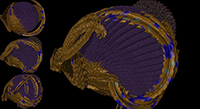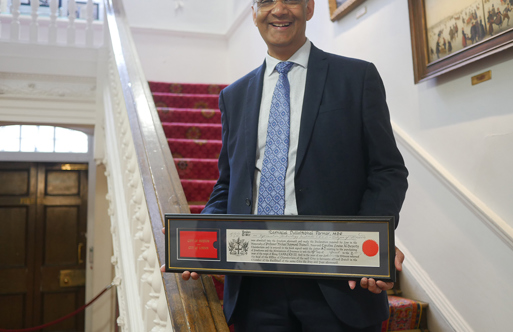 Click the image to enlarge
Click the image to enlargeCredit: William Latham, Mutator 2 Evolving Form, 2013
Copyright the artist, reproduced with permission.
Bizarre, strange mutated forms looming out of computer space; this artist is a gardener steering and evolving forms within a kind of virtual evolution. These images lead us to imagine we are being allowed in on the secrets of the universe. For William Latham the use of the computer offers a ‘huge space of endless predetermined possibilities.’
Like the Algorists whose work we have explored in this column, William sees the computer as a creative partner, with the artists’ ideas about form, colour and structure embodied in software.
His Mutator system is a highly sophisticated instrument for creating evolutionary art, as seen in our image this month. The work has an intriguing otherworldliness which draws us in, prompting questions of how it was created.
William has been developing Mutator art since the 1980s when he first began collaborating with mathematician Stephen Todd on an evolutionary system and found that ‘it would endlessly spawn computer art’.
The initial concept built on the ideas of evolution in the work of John H Conway’s Game of Life (1970) and the Richard Dawkins book The Blind Watchmaker (1986). In the Game of Life evolution is determined by its initial state, requiring no further input. One interacts with it by creating an initial configuration and observing how it evolves. Dawkins’ book is an explanation of, and argument for, the theory of evolution by means of natural selection.
Stephen Todd explains that Dawkins invented a system very like theirs, but Dawkins’ was designed to show the power of evolution. Stephen and William put these two theories together to produce a usable interface - the Mutator code for artistic creativity.
The artist chooses a model, based on his ideas, which acts as a ‘seed’ and sees what happens when it mutates and cross breeds, in order to generate further 3D forms. All iterations come from one basic algorithm. Thus the system allows the artist to evolve very organic type structures, as seen here.
The navigation of what is in effect a multi-dimensional design space allows for a huge amount of predetermined possibilities. And, as William explains, Mutator art has endless content possibilities and variations making it different from most other contemporary art being produced.
Over the years Mutator has received much press coverage for example in Scientific American as well as the art press. Recently Stephen Todd has been working on other (non-art) applications for the system, including architectural modelling.
Perhaps it is not surprising that William Latham was destined to become a ‘gardener artist’. Whilst a student he was influenced by art classes at the Museum of Modern Art Oxford where he was required to produce simple dances (aerial views of steps the dancers would take) using patterns to show the evolution of dynamic structures - a major departure for his work. The hand-drawn results formed the roots of this Mutator art.
Later, working for the Advanced Computer Graphics and Visualisation Division at IBM in the UK, William experienced a ‘return to Renaissance art’, in that the close working relationship between himself as a Royal College of Art trained artist and the scientists he encountered there were inspiring.
It was here he met Stephen Todd. Simultaneously Karl Sims in the USA began applying evolution to art, with Sims and Latham showing their work extensively at SIGGRAPH during that period.
William’s book Evolutionary Art and Computers (1992), was the first on this topic and is a key text. Later Jon McCormack in Australia (and later others still) applied the approaches of Latham and Sims in their practice.
William states that the forms he creates are devoid of content, if he sees an evolving form he likes he captures it. ‘It is fascinating to see what interpretations viewers bring to bear on the imagery - like an ink-blot test people see different things.’
He is currently working with the Neuroscience Group at UCL and is interested in perception and the psychology of viewing. He also enjoys hearing the comments of visitors. A recent example is from one visitor who said the work looked ‘Like the journey to the centre of an alien spaceship’.
William’s Mutator Art was recently on view in Brighton but if you missed it, you can see examples of the myriad of imagery he creates on his site.
Catherine Mason is the author of A Computer in the Art Room: the origins of British computer arts 1950-80, published in 2008.
More information on the Computer Arts Society, including our events programme

















